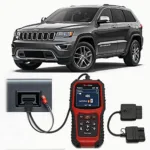OBD2 scanners are invaluable tools for diagnosing car troubles, but can you check oil pressure with OBD2? This is a common question among car owners, and we’ll explore the answer in detail. We’ll delve into the capabilities of OBD2, how it relates to oil pressure monitoring, and what alternative methods exist for checking this vital engine parameter.
Understanding OBD2 and its Capabilities
OBD2, or On-Board Diagnostics II, is a standardized system that allows external devices to access a vehicle’s diagnostic data. It’s primarily used to identify and troubleshoot engine and emissions-related issues. However, its functionality extends beyond just reading error codes. obd2 code 0303 Some vehicles provide access to a wide range of data, including speed, RPM, coolant temperature, and even fuel economy.
Does OBD2 Directly Measure Oil Pressure?
The answer isn’t always straightforward. While the OBD2 standard doesn’t require direct oil pressure monitoring, some manufacturers choose to include it. This means that some vehicles can indeed report oil pressure through the OBD2 port, while others can’t. using obd2 1998 dodge ram wont start This discrepancy often leads to confusion. If your vehicle doesn’t support OBD2 oil pressure readings, you’ll need to use alternative methods.
How to Check Oil Pressure if Your Car Doesn’t Support OBD2 Readings
There are a few reliable ways to check your oil pressure if your OBD2 scanner doesn’t provide this information:
-
Using a Mechanical Oil Pressure Gauge: This involves installing a dedicated pressure gauge directly into the engine’s oil system. It provides the most accurate readings but requires some mechanical knowledge.
-
Checking the Oil Pressure Warning Light: Most cars have a warning light that illuminates when the oil pressure drops below a critical level. While not as precise as a gauge, it provides a vital warning of potentially serious issues. obd2 aftermarket gauges
-
Consulting Your Mechanic: If you’re unsure about checking your oil pressure yourself, a qualified mechanic can quickly and accurately diagnose any potential problems.
What if My OBD2 Scanner Shows “No Data” for Oil Pressure?
If your OBD2 scanner isn’t displaying any oil pressure data, it’s likely that your vehicle doesn’t support this feature through the OBD2 port. Don’t panic! This is common in many car models. honda obd2 p1009 Consider using one of the alternative methods mentioned above to get an accurate reading.
“It’s important to remember that not all vehicles transmit oil pressure data via OBD2,” says automotive expert John Smith, ASE Certified Master Technician. “Always refer to your vehicle’s owner’s manual or consult a professional to determine the best way to monitor your car’s oil pressure.”
Why Checking Your Oil Pressure is Important
Maintaining proper oil pressure is crucial for engine health. Sufficient oil pressure ensures that all moving parts are adequately lubricated, reducing friction and wear. Low oil pressure can lead to serious engine damage, including overheating, bearing failure, and ultimately, engine seizure.
Conclusion
So, can you check oil pressure with OBD2? The answer depends on your vehicle’s make and model. While some cars support this feature, others don’t. ford obd2 code low oil pressure However, regardless of your vehicle’s OBD2 capabilities, regularly checking your oil pressure is essential for maintaining a healthy engine. Use the methods outlined in this article to ensure your engine is properly lubricated and protected from potential damage.
FAQ
- Why isn’t my OBD2 scanner showing oil pressure? Your vehicle may not support this feature through the OBD2 port.
- What should I do if my oil pressure is low? Consult a mechanic immediately.
- Is it expensive to check oil pressure? No, using alternative methods like a mechanical gauge or consulting a mechanic is relatively inexpensive.
- How often should I check my oil pressure? It’s a good practice to check it every time you change your oil.
- Can a bad oil filter cause low oil pressure? Yes, a clogged oil filter can restrict oil flow and lead to low pressure.
- What is a normal oil pressure reading? This varies by vehicle, consult your owner’s manual.
- Can high oil pressure be a problem? Yes, excessively high oil pressure can also indicate a problem.
For further assistance, contact us via WhatsApp: +1(641)206-8880, Email: [email protected] or visit our office at 789 Elm Street, San Francisco, CA 94102, USA. We have a 24/7 customer service team ready to help.


